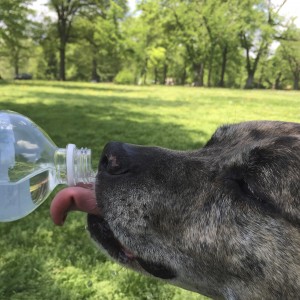Warm-Weather Pet Safety Quiz
 Take this short quiz and you may be surprised by the results. Of the following situations, which could prove dangerous for your pets? (Assume drinking water is freely available at all times.)
Take this short quiz and you may be surprised by the results. Of the following situations, which could prove dangerous for your pets? (Assume drinking water is freely available at all times.)
- Staying in the car for 20 minutes, in the shade, with the windows rolled half-way down
- Playing Frisbee on the beach for half an hour
- Running in the park for 25 minutes on a cloudy, but warm and humid, day
- Sleeping in the backyard with no shade
- Taking a long, leisurely walk through the city on a hot day
Answer? All of the above activities are potentially dangerous to your pets!
Un-Fun in the Sun
The same lovely weather that brings us outside for fun can create safety issues for our pets. Let’s say it’s 85o out and you all jump in the car to get a cool treat. You park in the shade, crack the windows and go enjoy yourselves. Unfortunately, by the time you return, it could be over 120o or higher in the car and your dog will be in grave danger. The afternoon will end with a desperate dash to the veterinarian instead of fun.
Playing Frisbee on the beach for half an hour (or even 10 minutes) creates a triple-whammy:
- UV rays are reflected off sand and water, increasing the exposure to damaging rays, and contributing to sunburn, skin cancers and cataracts
- It’s humid so panting doesn’t help much
- Sand can be so hot it actually burns your pet’s feet
- The excitement is hard to resist so your pet may play way past the time to cool down
Running in the park for 25 minutes on a cloudy, but warm and humid, day may result in the same situation as the beach – high humidity makes panting nearly useless, and exercising increases internal temperatures. Few dogs want to quit playing, so they may go past too hot to hyperthermic.
Sleeping in the summer sun all day, even if water is available, is dangerous. Sunlight equals heat, and no amount of drinking water will keep your pet from overheating or getting sunburned even on cloudy days, if there’s no shade.
Even a sedate saunter through town can cause trouble because sidewalks and pavements trap and reflect heat, while the surface temperature of the streets and sidewalks can burn a pet’s footpads.
Summer Pet Safety
Dogs are not very efficient when it comes to cooling themselves. Other than finding a pond, or shady spot to lie down, dogs can only cool themselves by panting and dilating capillary beds in their ears and face, transferring heat to the environment. However, these tactics only work when outside temperatures and humidity are lower than the temperature inside the dog. The closer the internal and external temperatures get – and the higher the humidity – the less cooling occurs.
And while cats rarely play Frisbee at the beach, they too can be accidentally locked in sheds or cars or otherwise become dangerously hot.
Way Too Hot
Even a few degrees higher than your dog’s normal temperature of 100.5o F to 102.5o F, and your dog will overheat. If your dog’s temperature rises to 105o F, he or she is on the way to a very dangerous condition called heat stroke. Heat stroke, if left untreated will cause a spiral of organ damage and often death.
If your pet is overheating (see below), Immediately put him or her in the shade or in air conditioning, and wrap in a wet, cool towel.
Your pet is in danger if he or she is showing any of the following symptoms:
- Excessive panting
- Lethargy, unresponsiveness, seizure activity, or loss of consciousness
- Bright red or blue gums
- Vomiting
Do not use ice, ice-water or even cold water to cool your pet – it will make the condition worse. Immediately take your pet to the vet or an emergency clinic, even if he or she seems to revive.
Avoiding Heat Stroke
- Avoid letting your pet overheat in the first place
- Carry a pet first aid kit and extra water for drinking and cooling off
- Be sure your pet has access to shade and clean water at all times
- Plan walks or exercise earlier in the day or in the evening when it’s cooler, and go at a slower pace
- Limit running and strenuous exercise in the heat
- If you know it’s going to be hot but you have no choice, douse your pet with water to increase evaporative cooling
If you have questions about warm weather activities and pet safety, or if your pet seems overheated, call us, we can help.


